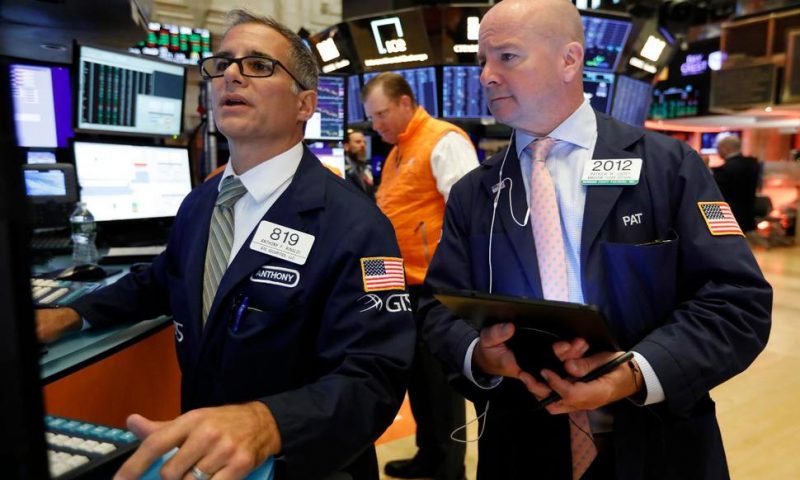Wall Street ended a choppy week of trading with a broad rally that drove the Dow Jones Industrial Average more than 370 points higher.
Wall Street ended a choppy week of trading with a broad rally that drove the Dow Jones Industrial Average more than 370 points higher.
The gains Friday also gave the S&P 500 index its best day in seven weeks, though the benchmark index still finished with its third straight weekly loss.
Technology, health care and financial stocks powered much of the rally, which was spurred by mixed job market data for September. The report showed that employers are still adding jobs at a healthy clip, albeit more slowly, and that the national unemployment rate dropped to a five-decade low.
The jobs report punctuated a rough week dominated by surprisingly weak numbers in surveys of manufacturing and service industries, which raised recession worries and sent the S&P 500 to its first back-to-back losses of 1% this year.
“There’s probably some relief this morning that the labor report didn’t confirm or enhance the weakness that we saw out of the two (economic) surveys,” said Bill Northey, senior investment director at U.S. Bank Wealth Management.
The S&P 500 rose 41.38 points, or 1.4%, to 2,952.01. The index finished the week with a 0.3% loss.
The Dow climbed 372.68 points, or 1.4%, to 26,573.72. The Nasdaq composite gained 110.21 points, also 1.4%, to 7,982.47. The Russell 2000 index of smaller company stocks rose 14.36 points, or 1%, to 1,500.70.
Stock markets around the world rose and gold dipped following the release of the U.S. jobs data as investors felt less need for safety.
The Labor Department said employers added 136,000 jobs last month, slightly less than the 145,000 that economists were expecting and below the 168,000 pace from August. Worker’s wages were also weaker than expected, with zero growth from a month before.
On the encouraging side, the government said hiring in prior months was stronger than earlier estimated, and the unemployment rate dropped to 3.5% from 3.7%.
“While the bears may take this as a further confirmation of a slower economy, it is actually a pretty strong read, especially when you factor in previous revisions” said Mike Loewengart, vice president of investment strategy at ETrade Financial.
If the job market can remain strong, it would allow U.S. households to keep spending. And that spending strength has been the hero for the economy recently, propping it up when slowing growth abroad poses a threat and President Donald Trump’s trade war with China saps exports and manufacturing.
Anticipation built through the week for the jobs report as a parade of weak data on the economy shook markets around the world. Manufacturing contracted last month at its sharpest pace in a decade, and growth in the nation’s services sector slowed.
Friday’s mixed report shows a jobs market that is slowing but still growing, and economists said it could signal that a rate cut at the Fed’s meeting later this month is no longer a slam dunk. The central bank has already cut rates twice this year to shield the economy from the effects of slowing growth abroad and the U.S.-China trade war.
The yield on the 10-year Treasury held steady at 1.53%. The two-year yield, which moves more on expectations about what the Fed will do, rose to 1.40% from 1.37%.
The world’s two largest economies are set to talk again next week about trade. Markets have been quick to swing on any hint of movement in their dispute, which has dragged on manufacturing around the world and pushed CEOs to delay investments given all the uncertainty.
“What market participants will be looking for is really what is the next trajectory?” Northey said. “Is it getting worse? Is it getting better? Is it status quo?”
The odds of Washington and Beijing hammering out a substantive deal in the near term are very low, he added.
“An agreement to continue to negotiate toward a mutually acceptable future endpoint is really what would be viewed as a success,” Northey said.
Technology, health care, financial and communication services stocks accounted for much of the market’s gains Friday. Visa rose 1.8%, UnitedHealth Group gained 2.1%, Citigroup added 2.2% and Google parent Alphabet picked up 1.8%.
Apple helped drive the market higher, rising 2.8%. A Japanese newspaper, Nikkei, said that the company asked suppliers to ramp up production of its iPhone 11. Moves in Apple’s stock have an outsized effect on the S&P 500 because it’s the second-largest constituent in the index by market size.
HP slumped 9.6% after the maker of personal computers and printers announced jobs cuts of up to 16% of the company’s payroll.
Crude oil recovered from an early slide to close with a modest gain. Still, it ended the week with a loss of 5.3%, reflecting worries about weakening demand and growing supplies.
Benchmark U.S. crude rose 36 cents to settle at $52.81 per barrel. It started the week at $55.91. Brent crude, the international standard, gained 66 cents to close at $58.37 per barrel.
Wholesale gasoline rose 1 cent to $1.57 per gallon. Heating oil climbed 1 cent to $1.89 per gallon. Natural gas rose 2 cents to $2.35 per 1,000 cubic feet.
Gold fell 90 cents to $1,506.20 per ounce, silver fell 5 cents to $17.54 per ounce and copper rose 1 cent to $2.56 per pound.
The dollar was unchanged at 106.87 Japanese yen from the yen on Thursday. The euro strengthened to $1.0984 from $1.0973.
Major European stock indexes finished higher.

